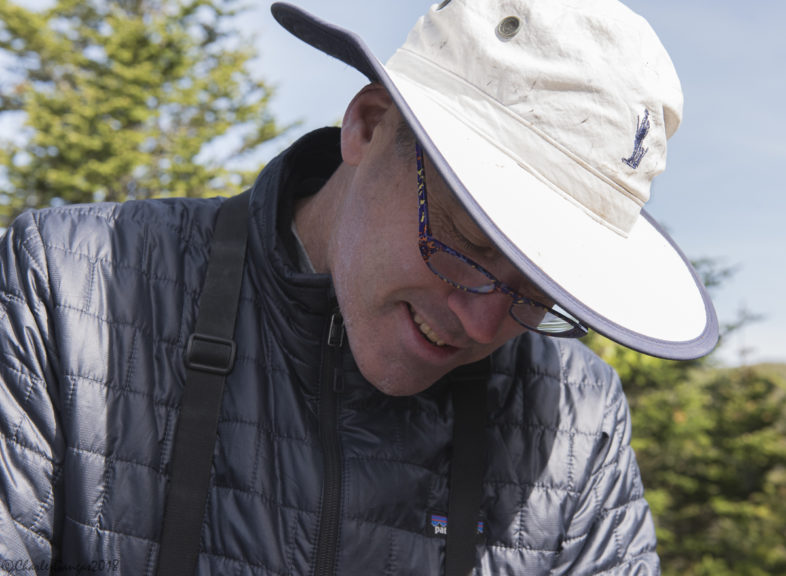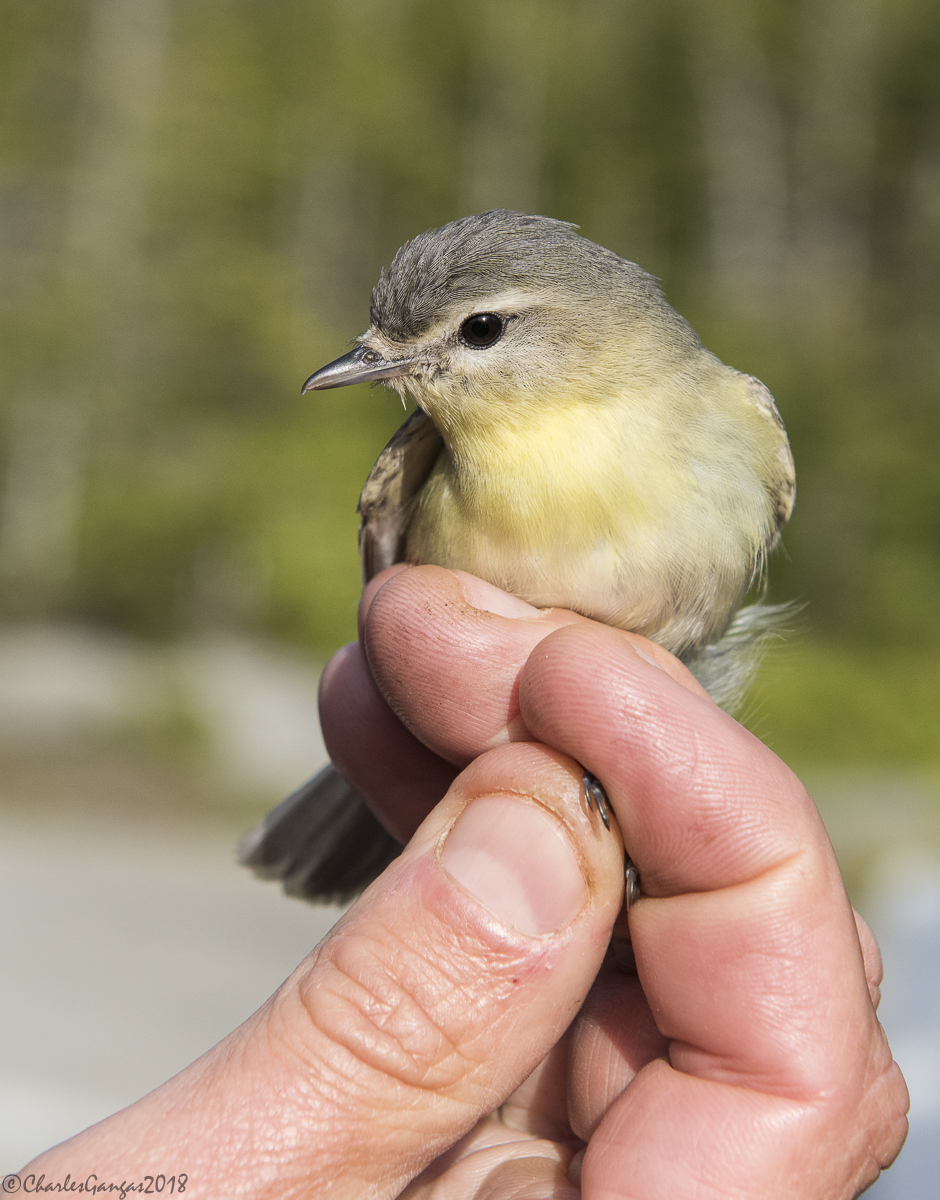
VCE’s first-ever Philadelphia Vireo mist-netted on Mt. Mansfield in 27 years of banding. © Charles Gangas
VCE’s third field visit to Mt. Mansfield on June 10-11 yielded several surprises among the 61 birds we captured in our 23 mist nets. Weather was favorable, though breezes blew a bit strong from the SW on Wednesday morning, when avian activity subsided rapidly after ~9:00 am.
Far and away, our most unexpected capture was a Philadelphia Vireo, the first we have encountered on Mansfield in 27 years of banding. The bird showed no signs of breeding and might have been a very late migrant, or just a non-breeding wanderer. The Second Atlas of Breeding Birds of Vermont documented only one nesting confirmation by this boreal species between 2003-2007, in the Northeast Kingdom, so this mid-June record is intriguing — it certainly provided a thrill for all of us. As has become increasingly common in recent years, although more often later in the season, we captured several species characteristic of northern hardwoods forests, such as Least Flycatcher Brown Creeper, Black-and-white Warbler, and Black-throated Green Warbler. We suspect that most of these out-of-habitat birds are failed or non-breeders.
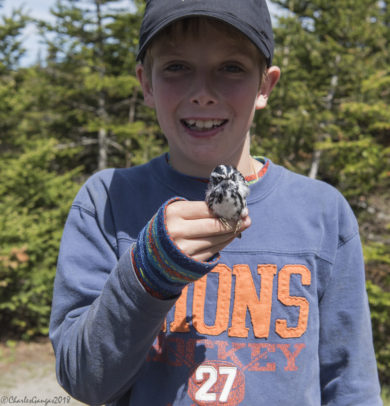
Quinn Collins shows off a handsome Black-and-white Warbler on Mt. Mansfield. © Charles Gangas
The capture of a juvenile White-winged Crossbill with incompletely-grown flight feathers was another notable surprise, and strongly suggests that the bird was locally hatched. That may help explain our capture of the same adult crossbill pair during each of the previous two weeks’ banding sessions. This bird, however, represented our only encounter with the species on the ridgeline this week. We’ve always assumed that the crossbills we see sporadically on Mansfield — usually in years following bountiful cone crops — were nomadic post-breeders, but this juvenile couldn’t have fledged more than a week or 10 days earlier. A few small flocks of siskins were still present on the ridgeline, and we captured three individuals.
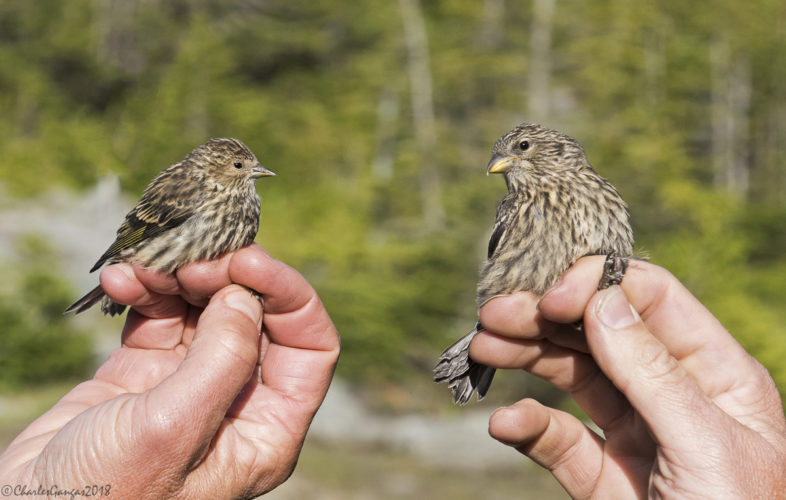
Juvenile Pine Siskin and White-winged Crossbill captured on Mt. Mansfield. © Charles Gangas
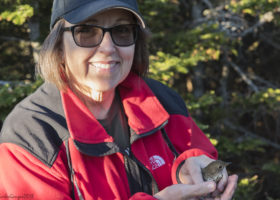
Elizabeth Ruml prepares to release one of 14 Bicknell’s Thrush captured over a two-day period on Mt. Mansfield. © Charles Gangas
Bicknell’s Thrush continue to make a good showing, and we have now captured 30 individuals so far this season. Given last fall’s abundant cone crop, it is perplexing that we still have not encountered a single red squirrel on Mansfield — I was on Okemo Mountain on June 9 and ran into half a dozen up there. It looks like a very light balsam fir cone crop emerging this year.
Our 2-day List of Mist-netted Birds
Least Flycatcher — 1 ——adult of unknown sex
Philadelphia Vireo — 1 adult, the first individual of this species captured on Mansfield in 27 years Brown Creeper — 1 female with beginning brood patch, possibly a failed breeder
Ruby-crowned Kinglet — 1 male
Bicknell’s Thrush — 14, including 6 new, 3 returns (birds from 2015, 2016 and 2017), 5 within-season recaptures
Swainson’s Thrush — 3 (1 return from 2016, 2 from 2017)
American Robin — 4 new bandings (1 male, 3 females with full incubation/brood patches)
Black-and-white Warbler — 1 yearling male
Blackpoll Warbler —11, including 3 new, 5 returns (2 from 2016, 3 from 2017), 3 within-season recaptures)
Yellow-rumped Warbler (Myrtle) — 6, including 3 new, 1 return from 2016, 2 within-season retraps; 2 females had fully-developed incubation patches)
Black-throated Green Warbler — 1 female with regressing brood patch; probably a failed breeder
Dark-eyed Junco (Slate-colored) — 3
White-throated Sparrow — 8 (6 new, 2 within-season recaptures)
Purple Finch — 2 (1 male, 1 female with fully-developed incubation/brood patch)
White-winged Crossbill — 1 locally-hatched juvenile with stubby tail and wings (~2/3 grown)
Pine Siskin — 3 (2 juveniles, 1 adult female)
An added and most welcome dimension of this week’s field session was the involvement of VCE’s Board of Directors, who, with Advisory Council (and recently retired Board) member Elizabeth Ruml, joined us on the mountain. Their energy, enthusiasm and active participation made our visit all the more lively, and we think it’s safe to say that they each learned a great deal about our long-term work on mountain birds.
With our first three weekly 2018 banding sessions now on the books, we look forward to additional surprises and discoveries as the avian breeding season progresses. Stay tuned.
